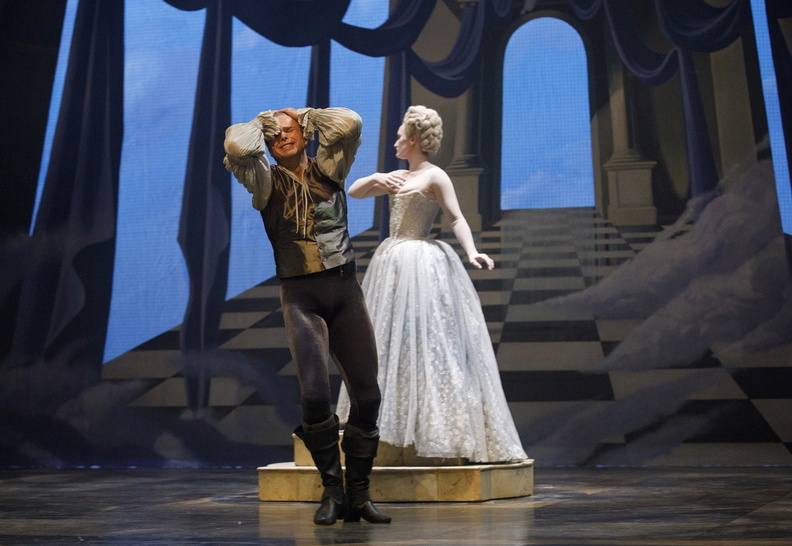Marc-Antoine Charpentier. Tireless professional. Jean-Philippe Rameau. Restless innovator. Two composers separated by little more than half a century. And a groundswell of change.
Working at the outer edges of a fashionable social circle that spiralled more and more tightly towards the king, the two seasoned composers found ready employment in the salons of affluent Parisians. All was not as either ideally wished at first. Charpentier, maître de musique to a worldly, deeply devout duchess. Rameau, resident maestro to a well-connected bourgeois financier. Each experienced, for all their distinctive brilliance, decidedly limited influence at court until essentially the close of their careers. The Byzantine system of royal patronage that flourished during the reign of Le Roi Soleil and his grandson, Louis XV, was slow to recognize and reward those deemed interlopers. Add the changeable winds of artistic fashion plus the oddly personal antagonism of cultural gatekeepers on the order of Jean-Baptiste Lully and Jean-Jacques Rousseau and Charpentier and Rameau were guaranteed a precipitous climb up the slippery gilded slopes of the French Baroque.
Spotlighting a pair of sparkling, one-act opéra-ballets, each conceived at opposite ends of a remarkable age of genius, Canada’s internationally acclaimed ambassador of early music theatre, Opera Atelier, floods the Elgin Theatre with wonder, the company’s new production of Actéon and Pygmalion as affecting as it is elegant. Charpentier and Rameau are glowingly celebrated.
The first offering on the program, Charpentier’s intricate setting of the antique Ovidian account of Actéon, the intemperate hunter struck down by the gods for spying on Diana as she bathes, strikes a decidedly moral note. Likely written as a cautionary tale for Louis XIV’s eldest son, the Dauphin in 1684 — the exact details of composition and debut performance are largely a matter of speculation — Actéon is pure allegory in action. Metaphors are rendered conspicuously palpable.
Goddess and nymphs beguile. The hunter draws closer. He stumbles. The intruder is discovered. Magically transformed into a stag, Actéon bounds away in terror. Slathering hounds off stage fell their former master, tearing at his flesh. Predator becomes prey. The perils of lasciviousness are made abundantly clear.
Drawing as much on movement as music, pose and expression as plot, director Marshall Pynkoski details Charpentier’s graphic fable with great style and finesse. Choreographer Jeanette Lajeunesse Zingg floats her dancers on a steady stream of melody, grace personified, tender, swirling, charming. Set designer Gerard Gauci’s striking painted drops rise and fall, nature abstracted — a forest of the imagination. Imagery and costumes, all linen and toile and leather, are stunning. Actéon entrances.
Appearing in the title role, tenor Colin Ainsworth channels the spirits of haut-contres past in a glorious demonstration of sheer, unadorned Francophone virtuosity, seizing command early in the proceedings with an irresistible rendition of Actéon’s irrepressible ariette, Liberté, mon coeur, liberté.
Soprano Mireille Asselin is an assertive, no-nonsense Diana, goddess of the hunt, a lustrous Meghan Lindsay stealing our hearts as her love-weary attendant, Aréthuze. Allyson McHardy is Junon, a darkly vengeful dea ex machina.
Soloist Edward Tracz dances a dazzling Actéon-cum-stag ablaze with grands jetés.
An updated presentation of an original instrumental work by folk-baroque violinist Edwin Huizinga, recently commissioned by Opera Atelier, raises the curtain on the second half of the bill. First performed in Toronto in semi-staged concert form at the Royal Ontario Museum last February, Inception, a haunting conversation between musician and dancer/choreographer, Tyler Gledhill, assumes almost spiritual proportions in this, its most recent incarnation. A wispy plaintive appeal summons winged Eros, melody morphing into pulsing Celtic-flavoured chords. Yearning segues to passion, passion to devotion as Eros weaves his spell. The power of this compact little intermezzo is electrifying. Huizinga and Gledhill soar, movingly bridging from the intimacy of the moment to the exhilaration and sweeping physicality of the final Rameau piece to follow.
Pygmalion, libretto by playwright Ballot de Sauvot, a boisterous retelling of the enduring myth of a lovelorn sculptor’s statue come to life, was promptly acclaimed by the composer’s rabid supporters, les ramoneurs, as a mini-masterpiece the instant it premiered to the public in 1748. French influence and authority may have been in marked decline abroad during the reign of Louis XV but in the city palaces and grand maisons de ville of Paris, exuberance and celebration was the order of the day. The Rococo had well and truly dawned. Pygmalion was a perfect fit.
A luscious air of sensuality prevails throughout this unapologetically voluptuous production. The potent eroticism of the central conceit — again courtesy Ovid’s Metamorphoses— of statue as object of desire subtly evoked. Cavalcades of alluring dancers. Sinewy, athletic staging. Pynkoski and Lajeunesse Zingg work as one, partners in enchantment. Time and time again, dance takes centre stage. None of his peers arguably before or since approached the artform with greater affection or understanding than Rameau. Pygmalion is a virtual encyclopaedia of ballet as it existed in his day. A host of genres is showcased by way of inducting Pygmalion’s formerly inanimate inamorata, Galatée, into the world of mid-18th century customs and mores.
But comedy and laughter also have their place, as the director is quick to remind us, in any serious salute to life and love. A preposterous commedia dell’arte vignette is quickly sketched, a slapstick parody of the story, Colombina assuming the role of sculptor, Arlecchino starring as disembodied bust. Rameau would surely have appreciated the buffonery given the level of invective hurled in his direction by diehard traditionalists, the prickly lullistes, centering on his use of ungodly Italianate forms.
There is a newness to Rameau’s score, a directness, a sense of barely restrained excitement edging to dissonance that feels vastly removed from the formality of French classicism. An exceptionally well-balanced Tafelmusik Baroque Orchestra under the practiced leadership of conductor David Fallis quite simply lives this music, capturing every inflection, every twist of harmony, every ritornelle in Pygmalion with unsurpassed dexterity.
Reappearing in a second leading role, Colin Ainsworth gifts us with a magnificently radiant performance, confident, supremely lyrical, perfectly ornamented. L’Amour triomphe, Rameau’s ringing declaration of purpose that closes the events of the evening, is given particularly thrilling expression, chorus echoing the upsweep of elation. Tenor and choir merge. The University of Toronto’s Schola Cantorum joined by members of the Choir of the Theatre of Early Music, all under the direction of Daniel Taylor, send the music heavenwards, Ainsworth’s bright, coloratura in the lead. The effect is utterly mesmerizing.
Meghan Lindsay appears as Galatée, purity and innocence personified. Allyson McHardy sings Pygmalion’s spurned lover, Céphise. Mireille Asselin is busy, bustling Amour, stage manager in the eternal drama of hearts broken and mended.
With plans well underway to tour Actéon & Pygmalion to Chicago’s Harris Theatre then on to the Opéra Royal in Versailles, Opera Atelier continues to expand its horizons. This is an exceptional company deserving long, loud applause. The world needs more Pynkoski and Lajeunesse Zingg.
* * *
Above: Colin Ainsworth & Meghan Lindsay in Pygmalion. Photo by Bruce Zinger


